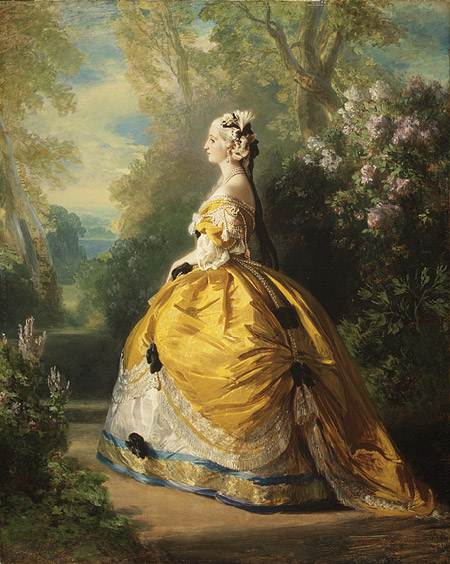It's interesting to think about how much fashion has changed over the centuries. I was hanging out with a friend the other night talking about wanting to have an occasion to wear a ball gown to. In today's society, it is quite rare where one has the occasion to dress up so formally. Other than one's wedding day... you would be hard pressed to find another excuse. However, what we, in the contemporary world, consider uber-fancy was once considered everyday dress. Yes, I am usually talking about the elite here, most of fashion history is a documentation of the elite dress at any given point in time. One of my favorite periods in costume history to study is 18th and 19th century France. Learning the history of extravagance, political implications, and larger-than-life personalities will take you a lifetime.
I've always loved this portrait of Empress Eugenie, wife to Napoleon III, by Franz Winterhalter (1854) at The Met. The style of her dress is classically 18th century though. Eugenie was known to have a strong affinity, obsession even, with the late Marie Antoinette and is trying to emulate her in this official portrait. Her hair is powdered white, and Eugenie would have had naturally raven hair as she was from Spain. Her dress is ornately decorated with lace edges and black ribbon bows. To have black fabric in those days was a sign of luxury. True black garments were costly to dye and necessitated a labor-intensive and timely process. Her dress is adorned with various strings of pearls and we can assume that the vibrant yellow and blue satin trim fabrics would have been of the highest quality. The lace and fringe trimmings are also probably the best hand-made products.
Although Eugenie loved to emulate fashions of the past, she was a tastemaker in her own right. In this portrait, you can see that she makes a 19th century addition to the 18th century style dress with the cage crinoline. Eugenie is often attributed as setting the trend for wearing cage crinolines, and loved the trend of voluminous skirts. She was an important patron for Charles Frederick Worth, known as the first couturier.
 |
| -Hillwood Museum- Franz Winterhalter, 1857, oil in canvas |

















































